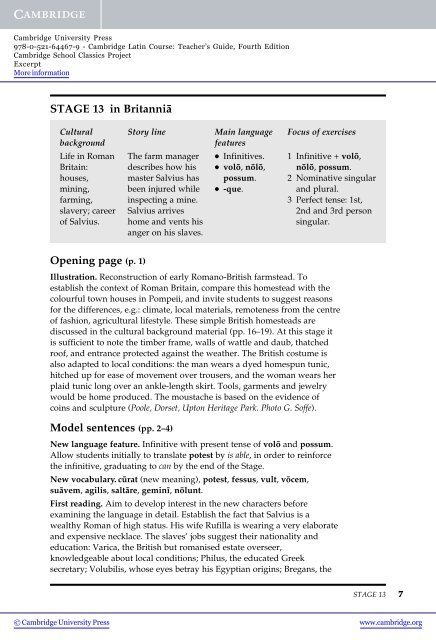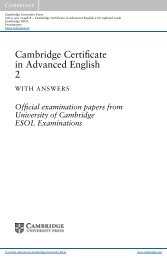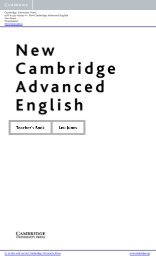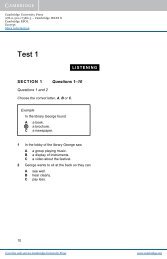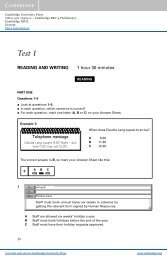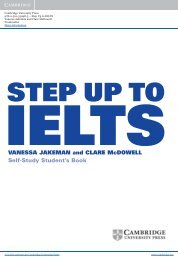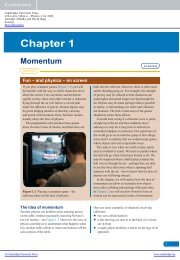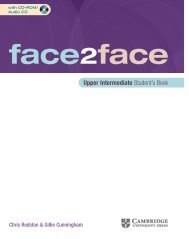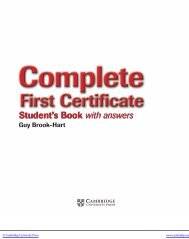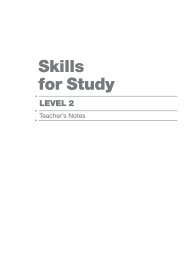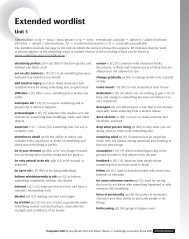STAGE 13 in Britanni¶ - Assets - Cambridge University Press
STAGE 13 in Britanni¶ - Assets - Cambridge University Press
STAGE 13 in Britanni¶ - Assets - Cambridge University Press
You also want an ePaper? Increase the reach of your titles
YUMPU automatically turns print PDFs into web optimized ePapers that Google loves.
<strong>Cambridge</strong> <strong>University</strong> <strong>Press</strong><br />
978-0-521-64467-9 - <strong>Cambridge</strong> Lat<strong>in</strong> Course: Teacher’s Guide, Fourth Edition<br />
<strong>Cambridge</strong> School Classics Project<br />
Excerpt<br />
More <strong>in</strong>formation<br />
<strong>STAGE</strong> <strong>13</strong> <strong>in</strong> Britanni<br />
Cultural<br />
background<br />
Life <strong>in</strong> Roman<br />
Brita<strong>in</strong>:<br />
houses,<br />
m<strong>in</strong><strong>in</strong>g,<br />
farm<strong>in</strong>g,<br />
slavery; career<br />
of Salvius.<br />
Story l<strong>in</strong>e<br />
Ma<strong>in</strong> language<br />
features<br />
● Inf<strong>in</strong>itives.<br />
● volº, nºlº,<br />
possum.<br />
● -que.<br />
Focus of exercises<br />
The farm manager<br />
describes how his<br />
master Salvius has<br />
been <strong>in</strong>jured while<br />
<strong>in</strong>spect<strong>in</strong>g a m<strong>in</strong>e.<br />
Salvius arrives<br />
home and vents his<br />
anger on his slaves.<br />
1 Inf<strong>in</strong>itive + volº,<br />
nºlº, possum.<br />
2 Nom<strong>in</strong>ative s<strong>in</strong>gular<br />
and plural.<br />
3 Perfect tense: 1st,<br />
2nd and 3rd person<br />
s<strong>in</strong>gular.<br />
Open<strong>in</strong>g page (p. 1)<br />
Illustration. Reconstruction of early Romano-British farmstead. To<br />
establish the context of Roman Brita<strong>in</strong>, compare this homestead with the<br />
colourful town houses <strong>in</strong> Pompeii, and <strong>in</strong>vite students to suggest reasons<br />
for the differences, e.g.: climate, local materials, remoteness from the centre<br />
of fashion, agricultural lifestyle. These simple British homesteads are<br />
discussed <strong>in</strong> the cultural background material (pp. 16–19). At this stage it<br />
is sufficient to note the timber frame, walls of wattle and daub, thatched<br />
roof, and entrance protected aga<strong>in</strong>st the weather. The British costume is<br />
also adapted to local conditions: the man wears a dyed homespun tunic,<br />
hitched up for ease of movement over trousers, and the woman wears her<br />
plaid tunic long over an ankle-length skirt. Tools, garments and jewelry<br />
would be home produced. The moustache is based on the evidence of<br />
co<strong>in</strong>s and sculpture (Poole, Dorset, Upton Heritage Park. Photo G. Soffe).<br />
Model sentences (pp. 2–4)<br />
New language feature. Inf<strong>in</strong>itive with present tense of volº and possum.<br />
Allow students <strong>in</strong>itially to translate potest by is able, <strong>in</strong> order to re<strong>in</strong>force<br />
the <strong>in</strong>f<strong>in</strong>itive, graduat<strong>in</strong>g to can by the end of the Stage.<br />
New vocabulary. c–rat (new mean<strong>in</strong>g), potest, fessus, vult, vºcem,<br />
suvem, agilis, saltre, gem<strong>in</strong>ª, nºlunt.<br />
First read<strong>in</strong>g. Aim to develop <strong>in</strong>terest <strong>in</strong> the new characters before<br />
exam<strong>in</strong><strong>in</strong>g the language <strong>in</strong> detail. Establish the fact that Salvius is a<br />
wealthy Roman of high status. His wife Rufilla is wear<strong>in</strong>g a very elaborate<br />
and expensive necklace. The slaves’ jobs suggest their nationality and<br />
education: Varica, the British but romanised estate overseer,<br />
knowledgeable about local conditions; Philus, the educated Greek<br />
secretary; Volubilis, whose eyes betray his Egyptian orig<strong>in</strong>s; Bregans, the<br />
<strong>STAGE</strong> <strong>13</strong><br />
7<br />
© <strong>Cambridge</strong> <strong>University</strong> <strong>Press</strong> www.cambridge.org
<strong>Cambridge</strong> <strong>University</strong> <strong>Press</strong><br />
978-0-521-64467-9 - <strong>Cambridge</strong> Lat<strong>in</strong> Course: Teacher’s Guide, Fourth Edition<br />
<strong>Cambridge</strong> School Classics Project<br />
Excerpt<br />
More <strong>in</strong>formation<br />
unromanised British labourer; the artistic tw<strong>in</strong>s bought by their<br />
sophisticated owners to provide home enterta<strong>in</strong>ment.<br />
Illustrations. Philus’ abacus <strong>in</strong> draw<strong>in</strong>g 4 may be familiar to students with<br />
younger sibl<strong>in</strong>gs. Abacuses are still used by market traders <strong>in</strong> the Middle<br />
East and Russia.<br />
tr•s servª (p. 5)<br />
Story. The slaves’ depression is lifted when the farm manager arrives with<br />
news that their master has been <strong>in</strong>jured <strong>in</strong> a plot.<br />
First read<strong>in</strong>g. Elicit by questions the slaves’ mood and the reasons for it. If<br />
necessary refer to the draw<strong>in</strong>gs on pp. 2–4 to identify <strong>in</strong>dividual slaves.<br />
Consolidation. Dramatic read<strong>in</strong>g of the story <strong>in</strong> Lat<strong>in</strong>. A useful exercise to<br />
test accuracy occurs <strong>in</strong> Independent Learn<strong>in</strong>g Manual Stage <strong>13</strong>.<br />
Introduce the new format of the vocabulary: verbs are now listed as they<br />
occur <strong>in</strong> the story, followed by the <strong>in</strong>f<strong>in</strong>itive and mean<strong>in</strong>g; nouns are also<br />
listed as they occur, followed by the nom<strong>in</strong>ative s<strong>in</strong>gular and mean<strong>in</strong>g.<br />
Illustrations. Slave cha<strong>in</strong>s from Lord’s Bridge, <strong>Cambridge</strong>shire (left), and<br />
Anglesey (right). These illustrations make the po<strong>in</strong>t that slaves,<br />
particularly those work<strong>in</strong>g on large rural estates and <strong>in</strong> the m<strong>in</strong>es, could be<br />
cruelly treated, and will serve as a ‘trailer’ for the next story, coni–rtiº.<br />
coni–rtiº (p. 7)<br />
Story. Dur<strong>in</strong>g his <strong>in</strong>spection of an iron m<strong>in</strong>e, Salvius orders the death of a<br />
sick slave. The slave’s son manages to enter Salvius’ bedroom and wound<br />
him before be<strong>in</strong>g killed by the guards. Salvius demands that all the slaves<br />
should be put to death as a reprisal, but has to be content with the<br />
execution of the guards.<br />
First read<strong>in</strong>g. As an <strong>in</strong>troduction, ask the students to recall from Book I<br />
objects found <strong>in</strong> Pompeii that were made of iron: storage chests, tools,<br />
razors, stylª, pots and pans, gladiatorial weapons. Brita<strong>in</strong>’s reputation for<br />
m<strong>in</strong>eral wealth was one of the reasons for the Roman conquest, and it is<br />
likely that one of Salvius’ duties was to maximise the benefits to the<br />
imperial government. There are useful comprehension questions <strong>in</strong><br />
Independent Learn<strong>in</strong>g Manual Stage <strong>13</strong>.<br />
Discussion<br />
1 Read the section on the career of Salvius on p. 21. Establish that he is a<br />
much more important figure than any of the characters the students<br />
have met so far <strong>in</strong> the Course. Ask students to refer to their read<strong>in</strong>g<br />
when answer<strong>in</strong>g the question beneath the draw<strong>in</strong>g. Does the fact that<br />
Salvius may have been pressurised by the emperor to <strong>in</strong>crease the<br />
revenues from Brita<strong>in</strong> make him a more sympathetic figure<br />
8 <strong>STAGE</strong> <strong>13</strong><br />
© <strong>Cambridge</strong> <strong>University</strong> <strong>Press</strong> www.cambridge.org
<strong>Cambridge</strong> <strong>University</strong> <strong>Press</strong><br />
978-0-521-64467-9 - <strong>Cambridge</strong> Lat<strong>in</strong> Course: Teacher’s Guide, Fourth Edition<br />
<strong>Cambridge</strong> School Classics Project<br />
Excerpt<br />
More <strong>in</strong>formation<br />
2 Is coni–rtiº a suitable title for the story Does the title reflect the<br />
Roman paranoia about slave rebellions, especially <strong>in</strong> situations where<br />
the slaves were likely to feel desperate<br />
3 Discuss the rights of slaves and Roman justice. In Brita<strong>in</strong>, at the edge of<br />
the empire, Roman officials were largely unsupervised and might be<br />
oppressive. Re<strong>in</strong>force the discussion by a read<strong>in</strong>g of The slaves <strong>in</strong> the<br />
background material (p. 20).<br />
4 Generate suspense by ask<strong>in</strong>g how the three slaves would react to the<br />
news of Salvius’ <strong>in</strong>jury and his imm<strong>in</strong>ent homecom<strong>in</strong>g.<br />
Consolidation. Note the switch back to past tenses. Worksheet Master <strong>13</strong>.1<br />
offers a revision exercise on tenses.<br />
Illustrations. Roman bloomery (smelt<strong>in</strong>g) site at Beauport Park, 5km from<br />
the coast at Hast<strong>in</strong>gs, East Sussex, the most extensive m<strong>in</strong>e <strong>in</strong> the area. The<br />
tiles stamped CL BR (classis Britannica) are from a bath house on the site.<br />
M<strong>in</strong><strong>in</strong>g iron was arduous at every stage. Slave labour was used for:<br />
extract<strong>in</strong>g the rock from the ground; manhandl<strong>in</strong>g the bellows to br<strong>in</strong>g the<br />
furnaces to a temperature hot enough to purify the metal; hammer<strong>in</strong>g and<br />
re-heat<strong>in</strong>g the iron to ref<strong>in</strong>e it further; and transport<strong>in</strong>g the iron pigs. The<br />
Roman fleet had a role rather like that of the Royal Eng<strong>in</strong>eers; it was<br />
responsible for road and bridge build<strong>in</strong>g and eng<strong>in</strong>eer<strong>in</strong>g of all k<strong>in</strong>ds,<br />
<strong>in</strong>clud<strong>in</strong>g m<strong>in</strong><strong>in</strong>g. Some small m<strong>in</strong>es were privately owned and some were<br />
let out to private contractors.<br />
Bregns (pp. 8–9)<br />
Story. Varica summons the slaves to parade for <strong>in</strong>spection. Bregans br<strong>in</strong>gs<br />
a hunt<strong>in</strong>g dog, a gift from K<strong>in</strong>g Cogidubnus. On his arrival Salvius is<br />
irritated by Bregans’ attempts to draw his attention to the dog, and strikes<br />
him to the ground. The dog jumps at Salvius, who decides to punish<br />
Bregans <strong>in</strong>stead of the dog.<br />
First read<strong>in</strong>g. Read the story aloud <strong>in</strong> Lat<strong>in</strong>, and let the students explore it<br />
<strong>in</strong> groups before tackl<strong>in</strong>g the questions on p. 9 with the whole class. Keep<br />
up the pace to susta<strong>in</strong> <strong>in</strong>terest <strong>in</strong> the new situation. Students could<br />
produce written answers for homework as consolidation of the oral<br />
discussion. Where the answer is a matter of op<strong>in</strong>ion (questions 6, 11 and<br />
12), any answer should be accepted which is a sensible <strong>in</strong>terpretation of<br />
the situation and supported by reasons. The answers and mark scheme are<br />
as follows.<br />
Marks<br />
1 The master/Salvius was arriv<strong>in</strong>g. Varica told the tw<strong>in</strong>s to call<br />
the slaves <strong>in</strong>to the courtyard. 2<br />
2 celeriter cucurr•runt. They were frightened of Salvius. 2<br />
<strong>STAGE</strong> <strong>13</strong><br />
9<br />
© <strong>Cambridge</strong> <strong>University</strong> <strong>Press</strong> www.cambridge.org
<strong>Cambridge</strong> <strong>University</strong> <strong>Press</strong><br />
978-0-521-64467-9 - <strong>Cambridge</strong> Lat<strong>in</strong> Course: Teacher’s Guide, Fourth Edition<br />
<strong>Cambridge</strong> School Classics Project<br />
Excerpt<br />
More <strong>in</strong>formation<br />
3 The slave-girls were gett<strong>in</strong>g a bedroom ready for their master.<br />
Volubilis was prepar<strong>in</strong>g the d<strong>in</strong>ner. 2<br />
4 K<strong>in</strong>g Cogidubnus had sent the dog for Salvius. 1<br />
The dog was very fierce; it could chase wild animals very<br />
well/it was a very good hunt<strong>in</strong>g dog. 2<br />
5 Salvius was rid<strong>in</strong>g at the head of a large troop of horsemen.<br />
Accept 19 or 20 horsemen. 2<br />
6 Salvius made no reply; he was furious. 2<br />
Bregans shouted out (<strong>in</strong>stead of wait<strong>in</strong>g to greet Salvius when<br />
he and Varica approached)/he used Salvius’ name (<strong>in</strong>stead of<br />
referr<strong>in</strong>g to him as dom<strong>in</strong>e). 1<br />
7 He fell to the ground. 1<br />
8 The dog broke away from the row and made for Salvius. 2<br />
9 Some of the slaves. 1<br />
They broke away from the rows and dragged the dog back. 2<br />
10 He wanted to kill the dog. Bregans told him that his friend,<br />
K<strong>in</strong>g Cogidubnus, had given him the dog. 2<br />
11 No: he was eager to tell Salvius about the dog and meant no<br />
disrespect/it was not Bregans’ fault that the dog broke free<br />
and attacked Salvius/he was try<strong>in</strong>g to be helpful.<br />
Yes: Bregans should have had more sense than to alienate his<br />
cruel master/he should have had the dog under better<br />
control/he should not have brought the dog to the <strong>in</strong>spection<br />
<strong>in</strong> the first place/he shouldn’t have made a smart comment. 1<br />
12 Brave: he dared to answer Salvius back, thus sav<strong>in</strong>g the dog.<br />
Stupid: he should have had more sense than to anger his<br />
cruel master.<br />
Impetuous: he called out to Salvius when he should have<br />
kept silent.<br />
Cheeky: he should have addressed Salvius more respectfully. 2<br />
TOTAL 25<br />
Consolidation. This story is suitable for act<strong>in</strong>g. It can also form a base,<br />
when it has been read and discussed, for grammatical exercises, e.g.:<br />
1 1st and 2nd person of the imperfect (<strong>in</strong>troduced <strong>in</strong> Stage 12), by<br />
substitution for forms of the imperfect appear<strong>in</strong>g <strong>in</strong> the story. Ask<br />
students the mean<strong>in</strong>g of ambulbat (l<strong>in</strong>e 6), and then substitute with<br />
ambulbs, ambulbmus, etc.<br />
Similarly with the perfect, ask for the mean<strong>in</strong>g of <strong>in</strong>trv•runt (l<strong>in</strong>e 18)<br />
and then substitute <strong>in</strong>trvistis, etc.<br />
2 Verbs with no nom<strong>in</strong>ative stated, taken <strong>in</strong> context, e.g.:<br />
vªlicus per ºrd<strong>in</strong>•s ambulbat; servºs ªnspici•bat et numerbat (l<strong>in</strong>es 5–6).<br />
ubi sunt ancillae n–lls ancills videº (l<strong>in</strong>e 7).<br />
canis ferºcissimus est; b•stis optim• agitre potest (l<strong>in</strong>es 16–17).<br />
10 <strong>STAGE</strong> <strong>13</strong><br />
© <strong>Cambridge</strong> <strong>University</strong> <strong>Press</strong> www.cambridge.org
<strong>Cambridge</strong> <strong>University</strong> <strong>Press</strong><br />
978-0-521-64467-9 - <strong>Cambridge</strong> Lat<strong>in</strong> Course: Teacher’s Guide, Fourth Edition<br />
<strong>Cambridge</strong> School Classics Project<br />
Excerpt<br />
More <strong>in</strong>formation<br />
Bregantem ferºciter pulsvit (l<strong>in</strong>es 30–1).<br />
istum canem <strong>in</strong>terficere volº (l<strong>in</strong>e 35).<br />
Illustration. Detail of hunt<strong>in</strong>g mosaic from Carthage, 5th century AD<br />
(Tunis, Bardo Museum). The dog is about to seize a hare. The image is<br />
reversed to suit the page.<br />
About the language 1: <strong>in</strong>f<strong>in</strong>itives (pp. 10–11)<br />
New language feature. Present tense of volº, nºlº, possum, used with the<br />
<strong>in</strong>f<strong>in</strong>itive.<br />
Discussion. In paragraph 3, elicit from the students the comment that the<br />
end<strong>in</strong>gs of possum are the same as the forms of sum. In paragraph 5, ask<br />
for alternative translations of possum and encourage the most natural<br />
English version <strong>in</strong> each <strong>in</strong>stance.<br />
Consolidation. Students should learn to recognise and translate the<br />
<strong>in</strong>flections of the three verbs tabulated <strong>in</strong> paragraph 3. A useful oral<br />
exercise is to turn the examples <strong>in</strong> paragraphs 4 and 5 from s<strong>in</strong>gular to<br />
plural, or vice versa, and ask for a translation.<br />
After study<strong>in</strong>g the notes and the examples, ask different groups to look<br />
back at different stories, pick<strong>in</strong>g out and translat<strong>in</strong>g sentences conta<strong>in</strong><strong>in</strong>g<br />
<strong>in</strong>f<strong>in</strong>itives. If further practice is necessary, ask the class Lat<strong>in</strong> questions to<br />
which they can f<strong>in</strong>d the Lat<strong>in</strong> answer <strong>in</strong> the text, e.g.: from tr•s servª (p. 5)<br />
Q quis ad ·taliam redªre vult A Philus ad ·taliam redªre vult.<br />
Q quid Philus dªcit<br />
A ego ad ·taliam redªre volº.<br />
Illustration. Colour-coated hunt beaker made <strong>in</strong> the Nene valley near<br />
Peterborough. The quarry, a hare, is on the reverse. The animals and<br />
decorative swirls are made by trail<strong>in</strong>g liquid clay onto the surface of the<br />
pot before fir<strong>in</strong>g (By courtesy of Verulamium Museum, St Albans. Photo<br />
Jennifer Lowe).<br />
**Salvius fundum ªnspicit (p. 12)<br />
Story. Varica conducts Salvius around the farm. See<strong>in</strong>g the ploughmen<br />
idle because the foreman is ill, Salvius wants to deny them food and sell<br />
the foreman. He is also annoyed because a new barn has collapsed when<br />
charged by a bull <strong>in</strong> the care of Bregans.<br />
First read<strong>in</strong>g. Divide the story <strong>in</strong>to two or three parts. After read<strong>in</strong>g part<br />
of the story aloud <strong>in</strong> Lat<strong>in</strong>, allow the students time to explore it. Then<br />
check their understand<strong>in</strong>g and <strong>in</strong>terpretation with comprehension<br />
questions, e.g.:<br />
What did Salvius want to do<br />
Who took him over the farm<br />
What did Varica say about the harvest<br />
<strong>STAGE</strong> <strong>13</strong><br />
11<br />
© <strong>Cambridge</strong> <strong>University</strong> <strong>Press</strong> www.cambridge.org
<strong>Cambridge</strong> <strong>University</strong> <strong>Press</strong><br />
978-0-521-64467-9 - <strong>Cambridge</strong> Lat<strong>in</strong> Course: Teacher’s Guide, Fourth Edition<br />
<strong>Cambridge</strong> School Classics Project<br />
Excerpt<br />
More <strong>in</strong>formation<br />
What was stored <strong>in</strong> the granary<br />
What was the name of the slave <strong>in</strong> charge of the ploughmen<br />
Why was he absent<br />
What was the effect of his absence<br />
When Salvius proposed to get rid of him, how did Varica defend him<br />
Why did Salvius grudge the ploughmen their food<br />
What did Salvius see near the granary<br />
Why was it half-ru<strong>in</strong>ed<br />
Why did Salvius consider Bregans stultior quam c•terª<br />
What impression do you get of Salvius as an estate owner<br />
Discussion. The read<strong>in</strong>g of this story should be comb<strong>in</strong>ed with a<br />
discussion of farm<strong>in</strong>g and slavery <strong>in</strong> Roman Brita<strong>in</strong> (pp. 16–20).<br />
1 Salvius as an estate owner. What impression do we receive of his<br />
<strong>in</strong>volvement and efficiency He has a manager, but takes a personal<br />
<strong>in</strong>terest <strong>in</strong> the farm. His impersonal approach to slaves would be<br />
regarded as normal, and is based on Cato’s advice to a landowner <strong>in</strong><br />
De Agri Cultura II.<br />
2 Varica’s character. Is he the right k<strong>in</strong>d of person to be farm manager<br />
3 The conditions of farm slaves. Why was the life of farm slaves generally<br />
much worse than that of domestic slaves Give examples from the lives<br />
of slaves encountered <strong>in</strong> this Stage and Book I.<br />
Illustration. Wall-pa<strong>in</strong>t<strong>in</strong>g from Trier show<strong>in</strong>g Gallo-Roman farmhouse<br />
consist<strong>in</strong>g of two blocks jo<strong>in</strong>ed by a colonnade. The master, wear<strong>in</strong>g his<br />
hooded travell<strong>in</strong>g cloak (left), arrives home to be greeted by his slaves.<br />
About the language 2: -que (p. <strong>13</strong>)<br />
New language feature. Use of -que to l<strong>in</strong>k words and sentences.<br />
Discussion. Emphasise the unchang<strong>in</strong>g form of -que, to avoid future<br />
confusion with the relative pronoun. After study<strong>in</strong>g paragraph 2, put up<br />
sentences on the board for students to rewrite us<strong>in</strong>g -que, e.g.:<br />
Vrica dom<strong>in</strong>um sal–tvit et fundum ostendit.<br />
Salvius agrºs circumspectvit et artºr•s quaesªvit.<br />
Salvius ad horreum adv•nit et aedificium s•mirutum cºnspexit.<br />
Consolidation. Oral practice of -que l<strong>in</strong>k<strong>in</strong>g two words can provide useful<br />
vocabulary revision. There is a further exercise <strong>in</strong> Independent Learn<strong>in</strong>g<br />
Manual Stage <strong>13</strong>.<br />
Practis<strong>in</strong>g the language (pp. 14–15)<br />
Exercise 1. Complete the sentences by select<strong>in</strong>g an appropriate <strong>in</strong>f<strong>in</strong>itive.<br />
Exercise 2. Complete the sentences by select<strong>in</strong>g a correct nom<strong>in</strong>ative,<br />
s<strong>in</strong>gular or plural.<br />
12 <strong>STAGE</strong> <strong>13</strong><br />
© <strong>Cambridge</strong> <strong>University</strong> <strong>Press</strong> www.cambridge.org
<strong>Cambridge</strong> <strong>University</strong> <strong>Press</strong><br />
978-0-521-64467-9 - <strong>Cambridge</strong> Lat<strong>in</strong> Course: Teacher’s Guide, Fourth Edition<br />
<strong>Cambridge</strong> School Classics Project<br />
Excerpt<br />
More <strong>in</strong>formation<br />
Exercise 3. A short read<strong>in</strong>g passage with gaps, to be completed by selection<br />
of verb <strong>in</strong> correct person of perfect tense. This exercise may be taken<br />
orally. Insist that each verb is translated <strong>in</strong> the context of the sentence as a<br />
whole. Encourage students to re-order the words <strong>in</strong> their translation, to<br />
produce the most natural English, e.g.:<br />
Because the slave was tired, he … (l<strong>in</strong>e 1)<br />
After Salvius entered the bedroom, he … (l<strong>in</strong>e 3).<br />
See ‘Language <strong>in</strong>formation’, p. 167, for similar examples.<br />
Illustrations. Scenes from rural life: man milk<strong>in</strong>g goat (p. 14), one man and<br />
his dog (p. 15). Details of mosaic from Daphne, suburb of Antioch, c. AD<br />
325 (Louvre).<br />
Language <strong>in</strong>formation: revision<br />
Revise the present, imperfect and perfect tenses (p. 160). Use exercises 1<br />
and 2 (p. 161, top) and further examples at the start or end of lessons so<br />
that the re<strong>in</strong>forcement value is <strong>in</strong>creased. Leave exercise 3 for later revision<br />
s<strong>in</strong>ce it conta<strong>in</strong>s the pluperfect <strong>in</strong>troduced <strong>in</strong> Stage 16. See also Worksheet<br />
Masters <strong>13</strong>.1 and Independent Learn<strong>in</strong>g Manual Stage <strong>13</strong>.<br />
Cultural background material (pp. 16–21)<br />
Content. Life <strong>in</strong> Roman Brita<strong>in</strong>: houses, m<strong>in</strong><strong>in</strong>g, farm<strong>in</strong>g, slavery; the<br />
career of Salvius. Study of this material should be <strong>in</strong>tegrated with read<strong>in</strong>g<br />
and language work, as suggested earlier.<br />
Discussion<br />
1 Houses. By study<strong>in</strong>g the illustrations trace the change from roundhouse<br />
(pp. 16–17) to rectangular house (p. 1 and the plan on p. 17) to the<br />
simple corridor house (p. 18) to the rich man’s elaborate villa of the<br />
fourth century AD (p. 17). Salvius’ villa would have been more<br />
elaborate than the corridor house on p. 18, but simpler than those of<br />
later centuries (p. 17). Stress the po<strong>in</strong>t that the com<strong>in</strong>g of the Romans<br />
probably made little difference to the great majority of peasant<br />
farmers, who cont<strong>in</strong>ued to live <strong>in</strong> round or simple rectangular houses.<br />
2 Agriculture. The Romans <strong>in</strong>troduced few changes <strong>in</strong> farm<strong>in</strong>g practice.<br />
In pre-Roman times the Britons had <strong>in</strong>creased their yields and were<br />
produc<strong>in</strong>g surpluses to market. There were further improvements <strong>in</strong><br />
the Roman period because of the <strong>in</strong>troduction of more efficient iron<br />
tools, which meant that more land could be cultivated. It was also<br />
easier to market produce because of Roman road build<strong>in</strong>g and the<br />
growth of towns.<br />
3 The status and work<strong>in</strong>g conditions of slaves. These varied considerably,<br />
from the household where some would have a close relationship with<br />
their master, to the estate or m<strong>in</strong>e where they worked <strong>in</strong> cha<strong>in</strong>-gangs<br />
<strong>STAGE</strong> <strong>13</strong><br />
<strong>13</strong><br />
© <strong>Cambridge</strong> <strong>University</strong> <strong>Press</strong> www.cambridge.org
<strong>Cambridge</strong> <strong>University</strong> <strong>Press</strong><br />
978-0-521-64467-9 - <strong>Cambridge</strong> Lat<strong>in</strong> Course: Teacher’s Guide, Fourth Edition<br />
<strong>Cambridge</strong> School Classics Project<br />
Excerpt<br />
More <strong>in</strong>formation<br />
under the control of a manager or overseer. The economy of the<br />
Roman empire depended on slave labour. Ever s<strong>in</strong>ce the near-success<br />
of the revolt of Celtic, German and Thracian slaves under Spartacus <strong>in</strong><br />
73–71 BC, the Romans lived <strong>in</strong> constant fear of another upris<strong>in</strong>g, and<br />
<strong>in</strong>subord<strong>in</strong>ation was met by the severest penalties.<br />
4 Salvius’ character and career. Salvius’ career shows that he was<br />
successful and ambitious. Do the fictional stories <strong>in</strong> this Stage re<strong>in</strong>force<br />
this Do they reveal other characteristics<br />
Illustrations<br />
p. 16 ● Bronze horse harness mount (79mm) from East Anglia, with red<br />
enamel decoration and swirl<strong>in</strong>g abstract patterns typical of Celtic<br />
taste (Photo courtesy of <strong>University</strong> of <strong>Cambridge</strong> Museum of<br />
Archaeology and Anthropology).<br />
● Reconstructed roundhouses and detail of wattle and daub, Butser<br />
Experimental Ancient Farm, near Petersfield, Hampshire.<br />
p. 17 ● Inside a roundhouse. Status is demonstrated by well-crafted<br />
objects rather than the functional architectural style. The entrance<br />
usually faced south-east to make the best of the morn<strong>in</strong>g sun and<br />
offer protection aga<strong>in</strong>st cold north w<strong>in</strong>ds. Separate rooms for<br />
different purposes, e.g. bedrooms, could have been made by<br />
hang<strong>in</strong>g leather or cloth between the uprights and the outer wall.<br />
The smoke from the fire would serve a useful purpose <strong>in</strong> smok<strong>in</strong>g<br />
jo<strong>in</strong>ts of meat and keep<strong>in</strong>g down verm<strong>in</strong> <strong>in</strong> the thatch. If wellseasoned<br />
wood was burned on the hearth the amount of smoke<br />
would have been tolerable (Photo Simon James).<br />
● After Roman Villas and the Countryside by Bédoyère (English<br />
Heritage). As shown by the broken l<strong>in</strong>e, the roundhouse has not<br />
been completely excavated.<br />
● Draw<strong>in</strong>g by Alan Sorrell of Lull<strong>in</strong>gstone Roman villa as it may<br />
have appeared <strong>in</strong> AD 360. At top centre is a temple-mausoleum, at<br />
top right a round temple. Salvius’ villa is imag<strong>in</strong>ed as that at<br />
Angmer<strong>in</strong>g near Worth<strong>in</strong>g (now covered up) which excavation<br />
showed to be unusually elaborate for the 1st century, with<br />
plann<strong>in</strong>g and craftsmanship only surpassed at Fishbourne.<br />
p. 18 ● Sheep at Butser. The Soay breed, found feral <strong>in</strong> the Outer<br />
Hebrides, has a bone structure identical with Iron Age<br />
archaeological f<strong>in</strong>d<strong>in</strong>gs. The bones on Roman sites relate to<br />
Shetland sheep. Shears first appear <strong>in</strong> the Roman period.<br />
● Reconstruction of villa near Verulamium, with thatched roof and<br />
tiled verandah. The lower walls are of stone, the upper of wattle<br />
and daub. Note: plough<strong>in</strong>g with a yoke of oxen, cabbages (highly<br />
valued by the Romans), chickens, cattle <strong>in</strong> pen, beehives <strong>in</strong> wood,<br />
timber-fell<strong>in</strong>g, water<strong>in</strong>g sheep at well.<br />
14 <strong>STAGE</strong> <strong>13</strong><br />
© <strong>Cambridge</strong> <strong>University</strong> <strong>Press</strong> www.cambridge.org
<strong>Cambridge</strong> <strong>University</strong> <strong>Press</strong><br />
978-0-521-64467-9 - <strong>Cambridge</strong> Lat<strong>in</strong> Course: Teacher’s Guide, Fourth Edition<br />
<strong>Cambridge</strong> School Classics Project<br />
Excerpt<br />
More <strong>in</strong>formation<br />
p. 19 ● Plough-team, 5cm high, 2nd–3rd century AD, found at Magis<br />
(Piercebridge), County Durham (British Museum). The yoked<br />
beasts pull forward a beam jo<strong>in</strong>ted just above soil level to a sickleshaped<br />
sole with an iron tip. This the man steers straight with his<br />
left hand, push<strong>in</strong>g it downwards with even pressure <strong>in</strong>to the soil,<br />
while goad<strong>in</strong>g his oxen forward with his right.<br />
● Emmer. The prote<strong>in</strong> value of ancient wheat was about twice that<br />
of most modern cereals. Cato (De Agri Cultura, LVI–LVII)<br />
recommends as the ration for cha<strong>in</strong>-gang slaves 2kg of bread a day<br />
<strong>in</strong> w<strong>in</strong>ter, 2.5kg when they were digg<strong>in</strong>g the v<strong>in</strong>es, but 2kg aga<strong>in</strong><br />
when the figs ripened. Ten amphorae of w<strong>in</strong>e per man a year<br />
(about 20l a month), presumably mixed with water, was<br />
reasonable (for pictures of amphorae, see model sentences to Stage<br />
14 and note <strong>in</strong> Independent Learn<strong>in</strong>g Manual Stage 14). Cato<br />
recommended that sick slaves had their rations reduced.<br />
● Co<strong>in</strong> m<strong>in</strong>ted <strong>in</strong> Camulodunum by Cunobel<strong>in</strong>, k<strong>in</strong>g of the<br />
Catuvellauni (d. AD 41), with CVN and horse on other side<br />
(British Museum). Under Claudius the Romans took over his tribal<br />
stronghold at Colchester as their first prov<strong>in</strong>cial capital, later<br />
transferr<strong>in</strong>g to London.<br />
p. 20 ● Bronze oil flask, 9cm high, 2nd century AD, from Isurium<br />
Brigantium (Aldborough), Yorkshire (British Museum). The slaveboy<br />
sits <strong>in</strong> his cloak, a lantern (probably) between his legs.<br />
p. 22 ● Rich torcs were commonly worn <strong>in</strong>to battle by warrior chiefta<strong>in</strong>s.<br />
They illustrate the high level of craftsmanship among the Britons,<br />
and the emphasis placed on portable wealth and status symbols.<br />
One of twelve c. 70 BC found <strong>in</strong> Snettisham, Norfolk.<br />
Suggested activities<br />
1 Writ<strong>in</strong>g, based on what students have read, e.g.: a story about a slave<br />
transferred from a farm to a m<strong>in</strong>e; or a group play about slaves’<br />
everyday life <strong>in</strong> a British villa or a conversation about Salvius between<br />
two friends, one who admires him and one who dislikes him.<br />
2 Exercises on British and Roman farm<strong>in</strong>g <strong>in</strong> Independent Learn<strong>in</strong>g Manual<br />
Stage <strong>13</strong> and Worksheet Masters <strong>13</strong>.3 and <strong>13</strong>.5.<br />
3 Study of a local villa.<br />
Vocabulary checklist (p. 22)<br />
Discuss the format used <strong>in</strong> the vocabulary checklists from now on: verbs <strong>in</strong><br />
1st person s<strong>in</strong>gular present, present <strong>in</strong>f<strong>in</strong>itive, 1st person s<strong>in</strong>gular perfect;<br />
nouns <strong>in</strong> nom<strong>in</strong>ative (the genitive is added <strong>in</strong> Stage 17).<br />
<strong>STAGE</strong> <strong>13</strong><br />
15<br />
© <strong>Cambridge</strong> <strong>University</strong> <strong>Press</strong> www.cambridge.org


